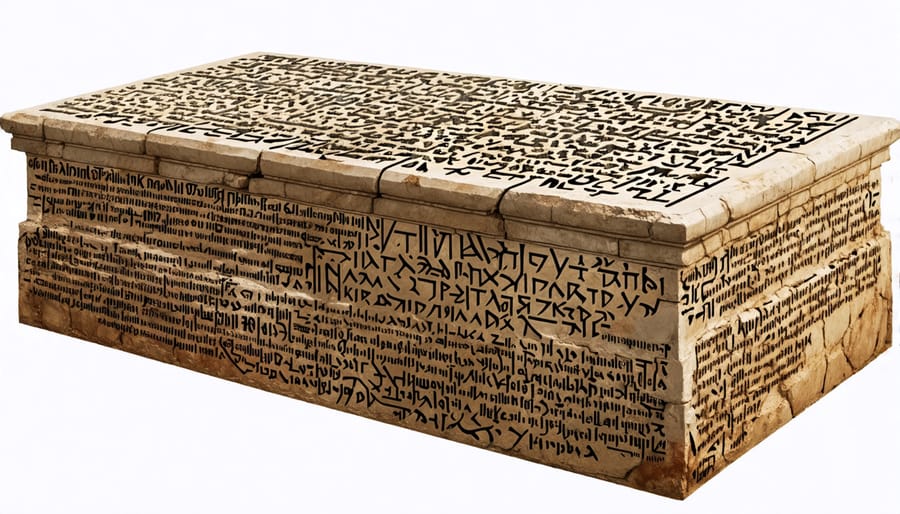For centuries, Christians have found their faith deepened and affirmed by the discoveries of history and archaeology. From ancient artifacts to crumbling ruins, the sands of time have yielded compelling evidence that illuminates the people, places and events of the Bible. These tangible reminders give us a clearer window into the world of scripture and the unfolding of God’s plan across the ages.
Remarkably, archaeologists continue to unearth finds that corroborate key details in the biblical record. Inscriptions mentioning Israelite kings, seals bearing the names of royal officials, even sites like Jericho and Gath – time after time, history and scripture converge to reveal the reliability of God’s Word. For believers seeking to strengthen their faith, this archaeological evidence provides a solid foundation.
Yet beyond merely confirming the Bible’s historicity, archaeology also enriches our understanding of the context and significance of biblical events. Discoveries like the Dead Sea Scrolls shed light on the formation and transmission of scripture. Household items, artwork and architecture paint a vivid picture of daily life in ancient times. As we dig deeper into this historical backdrop, familiar Bible stories take on new color and meaning.
Ultimately, the history and archaeology of the Bible remind us that our faith is firmly rooted in time and space. The God who spoke the universe into existence also entered into real human history to bring about his eternal purposes. And the traces of his working that archaeologists continue to uncover are powerful pointers to a larger story – one that you and I now find ourselves a part of. What role will we play as the next chapter unfolds?
The Dead Sea Scrolls
The Dead Sea Scrolls, discovered between 1947 and 1956 in the Qumran Caves near the Dead Sea, are a remarkable collection of ancient manuscripts that shed light on the history and preservation of the Bible. These scrolls, written on parchment and papyrus, date back to the period between the 3rd century BCE and the 1st century CE. They contain biblical texts, apocryphal works, and sectarian documents.
The biblical scrolls found at Qumran include fragments from every book of the Old Testament except for the Book of Esther. Notably, the Great Isaiah Scroll, which contains the entire text of the Book of Isaiah, is the oldest complete copy of a biblical book ever discovered. The Dead Sea Scrolls provide invaluable insights into the transmission and accuracy of the Old Testament manuscripts over time.
One of the most significant aspects of the Dead Sea Scrolls is their striking similarity to the Masoretic Text, the authoritative Hebrew text of the Old Testament used today. Despite the centuries that separate the Dead Sea Scrolls from the Masoretic Text, the consistency between the two is remarkable. This similarity provides compelling evidence for the faithful transmission of the biblical text throughout history.
The discovery of the Dead Sea Scrolls has been a source of great excitement for Christians, as it affirms the reliability and authenticity of the Old Testament. These ancient manuscripts serve as a powerful testament to God’s providence in preserving His Word for generations to come. As believers, we can have confidence in the Scriptures we read today, knowing that they have been meticulously transmitted and remain true to the original texts.

The Tel Dan Inscription
The Tel Dan Inscription, discovered in 1993 in northern Israel, provides fascinating evidence for the historical existence of King David’s dynasty. This broken stele, dated to the 9th century BCE, contains the phrase “beit david” (house of David), referring to the royal lineage descended from the famed biblical king.
As believers, this find offers exciting confirmation that the David we read about in scripture was a real figure who left a lasting impact. The Bible tells us that God chose David and promised him an enduring throne (2 Samuel 7:16), a dynasty that would ultimately lead to the Messiah. Centuries later, this inscription shows that David’s descendants were recognized as a royal house, corroborating the biblical account.
While faith does not hinge on archaeological discoveries, finds like the Tel Dan Inscription can bolster our confidence in scripture’s reliability. They remind us that the people and events described in the Bible were part of real history, not mere legends. As we study God’s word, this stele encourages us that we are encountering truth – a genuine record of how the Lord has worked through human affairs to bring about his saving purposes.
Though only a fragment, the Tel Dan Inscription offers a tangible link between the physical world and the spiritual truths we hold dear. It invites us to approach the Bible with expectant hearts, knowing that its message is firmly rooted in the realities of the past yet ever-living and powerful for faith today.

Hezekiah’s Tunnel
The discovery of Hezekiah’s Tunnel, an ancient engineering marvel in Jerusalem, stands as compelling evidence for the Bible’s historicity. As chronicled in 2 Chronicles 32, King Hezekiah of Judah, facing the imminent threat of the Assyrian army, took measures to protect Jerusalem’s water supply by constructing a tunnel to redirect the Gihon Spring’s waters inside the city walls. Remarkably, archaeologists have uncovered this very tunnel, confirming the biblical account.
Hezekiah’s Tunnel, also known as the Siloam Tunnel, stretches for approximately 1,750 feet, chiseled through solid rock beneath the City of David. What makes this feat even more astonishing is that the tunnel was excavated by two teams starting at opposite ends, meeting precisely in the middle. This achievement required advanced engineering skills and a deep understanding of the terrain, all undertaken in a time of great urgency and peril.
The tunnel’s existence, corroborating the Bible’s description, strengthens our faith in the accuracy and reliability of God’s Word. It reminds us that the events recorded in Scripture are not mere legends but historical realities, grounded in time and place. As we study passages like 2 Chronicles 32, we can take heart in knowing that our faith is built upon a firm foundation, with archaeological discoveries like Hezekiah’s Tunnel serving as tangible reminders of God’s faithfulness and the Bible’s trustworthiness. May this knowledge encourage us to dive deeper into the Scriptures, allowing its timeless truths to guide and transform our lives.
The Pilate Stone
The Pilate Stone, discovered in 1961 near Caesarea Maritima, Israel, is a remarkable find that offers tangible evidence for the historical existence of Pontius Pilate, the Roman governor who presided over the trial and crucifixion of Jesus Christ. This limestone block, measuring 82 cm by 65 cm, bears an inscription in Latin that reads, “Pontius Pilate, Prefect of Judea, has dedicated to the people of Caesarea a temple in honor of Tiberius.”
The significance of this discovery lies in its confirmation of Pilate’s role as a historical figure, just as described in the Gospels. It also sheds light on his title, “Prefect,” which is consistent with the way he is referenced in the Bible. The Pilate Stone thus serves as a powerful reminder that the events recorded in the New Testament are grounded in historical reality.
For Christians, this artifact is more than just an ancient relic; it is a tangible connection to the story of Jesus’ passion and a testament to the truthfulness of the biblical narrative. As we reflect on the Pilate Stone, we are reminded of the sacrifice Christ made for our salvation and the enduring power of God’s love, which transcends time and space.
Caiaphas Ossuary
In 1990, a remarkable discovery was made in Jerusalem—an ossuary, or bone box, bearing the Aramaic inscription “Joseph, son of Caiaphas.” This fascinating find likely refers to the high priest Caiaphas mentioned in the Gospels as presiding over Jesus’ trial and delivering Him to Pontius Pilate for crucifixion (Matthew 26:57-68; John 18:12-14).
The limestone box, dating to the first century AD, was uncovered in a burial cave south of Jerusalem. Its ornate decoration and the inscription’s reference to “Caiaphas” suggest it belonged to a prominent priestly family. While the ossuary does not prove the Gospel accounts, it does affirm the historical existence of the Caiaphas family and their role in first-century Judaism.
This artifact offers a tangible link to a key figure in the passion narrative. It reminds us that the events surrounding Jesus’ death, though profound in spiritual significance, are rooted in history. The Caiaphas ossuary invites us to reflect on the reality of Christ’s sacrifice and the opposition He faced from religious authorities.
As believers, we can take comfort in knowing that our faith is not based on myths or legends, but on real events that occurred in time and space. The Caiaphas ossuary, along with other archaeological discoveries, helps illuminate the historical context of Scripture and strengthens our confidence in the Bible’s truth. May this remarkable find encourage us to approach God’s Word with renewed awe and gratitude for the depths of His love demonstrated through Christ’s death and resurrection.

Conclusion
The archaeological evidence discussed in this article, from the Tel Dan Stele to the Dead Sea Scrolls, provides compelling support for the historical reliability of the Bible. These tangible artifacts offer a glimpse into the ancient world, corroborating key figures, places, and events described in Scripture. As Christians, we can take heart in knowing that our faith is rooted not only in spiritual truth but also in historical fact.
While archaeology alone cannot prove the divine inspiration of the Bible, it can strengthen our confidence in its accuracy and authenticity. Each discovery serves as a reminder that the stories we read in Scripture are not mere legends or myths, but accounts of real people, real places, and real events that unfolded in the context of human history. This knowledge can deepen our appreciation for the Bible and its central message of God’s love and redemption.
As you reflect on these archaeological finds and their significance, I encourage you to dive deeper into God’s Word. Allow these discoveries to ignite your curiosity and passion for studying Scripture, knowing that each page contains timeless truths that can transform your life. If you’re looking to enhance your understanding of the Bible’s historical and cultural context, consider exploring some trusted resources for further study, such as study Bibles, commentaries, and books by reputable biblical scholars.
Remember, while archaeology can illuminate and affirm our faith, ultimately, it is through the power of the Holy Spirit and the living Word of God that our hearts are changed and our lives are transformed. May these discoveries inspire you to draw closer to God, to trust in His faithfulness, and to share the hope that we have in Christ with those around you.
